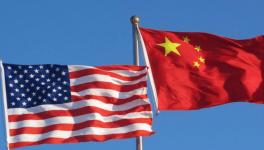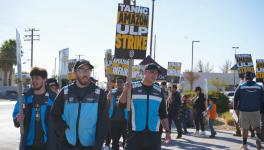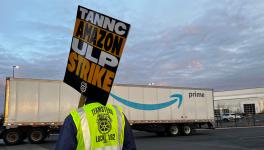Labour Notes 2022: US Workers Pushing Unions Into Mainstream
Euphoria about a US labor union revival was rife at the Labor Notes conference
Pushed to the edge by the pandemic and activated by the anti-police violence protests of 2020, workers in the United States are more assertive toward their employers unlike the country has seen in decades. They're increasingly active through labor unions, both outside the mainstream of organized labor and through reform movements within the most powerful unions of the US.
Claiming the uptick were some 4,000 grassroots activists, members and supporters of labor unions who attended the Labor Notes conference in Chicago from June 17 to 19.
"I think we have the opportunity to make the word 'union' no longer some taboo word that we're afraid to say in the workplace," said Kylah Clay, a Starbucks barista and organizer with Starbucks Workers United.
Supporters like Democratic Senator Bernie Sanders urged unions to seize the moment by building an upsurge rather than a blip
Climbing out of the rut
Since the 1980s, the American labor movement has been in decline. Over the past two years, however, there are signs that US labor may again be finding its footing.
"As someone who's studied labor issues for the last 30 years or so, I've never seen anything like it in terms of the level of interest and excitement from people who want to fight back at the workplace," said Stephanie Luce, a professor of labor studies at the CUNY School of Labor and Urban Studies, at the conference.
With union popularity at its highest since 1965 according to US pollster Gallup, union organizing appears to be newly contagious in the US. An uptick in private sector strikes at companies like John Deere, Kelloggs and Nabisco last fall — termed "Striketober" — also indicates renewed willingness by workers to participate in workplace actions. US President Joe Biden has declared his intent to be the "most pro-union president leading the most pro-union administration in history."
Unorganized workers are making headway. Starbucks, Amazon and also recently Apple workers have led stunning wins in their workplaces, which were previously considered unorganizable. At the time of writing, workers affiliated with Starbucks Workers United have filed for union elections in nearly 300 stores across 35 states, and have won more than 150 of them.
Also employees at the Apple Store at Grand Central Station in New York City have begun a process of unionization
In May, Amazon workers voted to unionize at an 8,300-employee Staten Island warehouse in New York City, surprising nearly the entire labor movement. Its successful organizing is considered a watershed for the US labor movement. The company, however, is challenging the election's results.
"The following weeks [after the election] there was euphoria," said Will Weiss, an Amazon worker at the Staten Island facility and an organizer with the Amazon Labor Union (ALU).
Labor union activists hope union wins at Starbucks and Amazon will inspire labor organizing across industries around the country, and potentially raise labor standards in their sectors. "We win a contract, guess how much better the other contracts in this country are going to be?" ALU President Chris Smalls told an audience of thousands at Labor Notes' main session.
A changing movement in a changed world
Labor experts emphasize the often lethal mistreatment of workers by employers during the pandemic. The pandemic was "the straw that broke the camel's back," according to Luce. "The pandemic really just pushed people over the edge in saying, 'I'm done with this. I'm not gonna put up with this anymore. I'm not going to risk my life, and I'm not gonna break my back.'"
Luce's colleague at CUNY, professor of urban studies Samir Sonti, also noted that the unusually tight labor market may be shifting people's risk preferences in workplace action. It's become easier for workers, especially in the service and hospitality industries, to quit and find another job.
In this way, the so-called Great Reshuffle of the past year — originally called "The Great Resignation," in which millions of workers changed jobs — may help explain the strengthening labor movement.
According to Weiss, another reason workers are more active included the Black Lives Matter movement in 2020, when millions of people took to the streets in righteous indignation at the murder of George Floyd, Breonna Taylor, Ahmaud Arbery and many others.
"That moment definitely did a lot to build the consciousness of working people," he said.
Kylah Clay, a lead worker organizer of the first Starbucks to unionize in Boston, argued it goes beyond just the summer of 2020. "The folks who are organizing right now, we've all been part of the 'Great Recession,' the pandemic ... we're watching global warming, we've seen George Floyd's murder. We've all been a part of these really horrific experiences that I think we want to address in an intersectional way. I think we've found that unions are one way that we can do that."
Unconventional unionism
In the US, organizing campaigns by large unions have typically been top-down efforts, in which unorganized workers follow the lead of union staff organizers. Recently, the most exciting victories have flipped this relationship: Union staff support and follow the lead of the workers as the main organizers of the workplace.
Weiss explained that the union victory at the Staten Island Amazon facility came from the workers themselves "having one-on-one conversations with workers, disrupting captive audience meetings."
Captive audience meetings are mandatory meetings for employees in which employers express their opinions about unions, often with assistance from hired anti-union consultants. Having workers in the meetings to call out any informational inaccuracies or to express their pro-union sentiment was a major boon to the effort.
Weiss also emphasized the importance of organizers having a presence in break rooms. "It gave us the opportunity to talk to workers, to make it clear being pro-union is not something that will get you fired."
Like many of the organizers at ALU and Starbucks, Clay knew practically nothing about ALU's efforts prior to organizing her store. "I'm really happy that I had no experience, in a way, because I followed my intuition. And that's what all of us are doing right now, is following our intuition on how to talk to our workers, our coworkers."
After wins at Starbucks and Amazon, long-time union organizers are reconsidering their strategic calculus
Starbucks Workers United is not independent, but its parent union Workers United intentionally takes a backseat to the workers, lending mostly resources rather than leadership.
The union has found success in a worker-to-worker approach. Like ALU, they also disrupt captive audience meetings and support their fellow workers facing union-busting tactics.
Old turns new
Attendees of the Labor Notes Conference also championed major changes at two of the largest and most powerful unions in the US.
In November 2021, members of the Teamsters union elected Sean O'Brien and his Teamsters United slate. O'Brien promises to bring the 1.3-million-member union out of complacency with employers, prioritize rank-and-file organizing, and push for better collective bargaining agreements, including for UPS workers whose contract is up in 2023.
Firing up the crowd, O'Brien said he would make 'zero concessions' toward UPS and put the company 'on its knees' if he had to
The United Auto Workers union also saw a significant shift in its 87-year history in December 2021. Prompted by a series of corruption charges brought against union leadership over the years, members voted overwhelmingly in a referendum in favor of a "one member, one vote" policy for union leadership elections. Previously, votes went via delegates to a convention.
At a panel on the subject, Scott Houldieson, a Ford auto worker, said the new direct voting system could mean rank-and-file auto workers have a better say in negotiations and the broader direction of the nearly 400,000-member union.
Difficulties ahead
Despite positive signs for the movement, labor in the US remains relatively weak and faces a number of political and economic challenges. According to the Bureau of Labor Statistics, union density has continued its decline, to 10.3% in 2021, which is down from its peak of 35% in 1954.
The Protecting the Right to Organize Act — the US labor movement's crown jewel of hopeful labor legislation — would open the flood gates to unionization by expanding collective bargaining rights, eliminating barriers, and strengthening union election access. But while President Biden supports the bill, its sponsors don't have the votes to pass it in Congress.
One major political defeat in recent history was a 2018 Supreme Court decision, which dealt a serious blow to public-sector unions by allowing employees to opt out of paying union dues or fees. Another was in 2020, when gig workers were exempted from many employee benefits and rights in California.
Finally, an economic recession could hurt labor's recent gains. "It is going to be harder to organize, strike or bargain for good contracts in a recessionary environment," Sonti said. He underscored, however, how the pandemic has "affected something in a deep way as far as what people are willing to tolerate."
According to Luce, the US labor situation is bad, with weak labor laws that are hard to enforce. "What's happening, is people are finally just cracking and saying, 'That's it.'"
And to a standing ovation at the Labor Notes Conference, Smalls declared defiantly that this summer is going to be "a hot labor summer."
Edited by: Uwe Hessler
Get the latest reports & analysis with people's perspective on Protests, movements & deep analytical videos, discussions of the current affairs in your Telegram app. Subscribe to NewsClick's Telegram channel & get Real-Time updates on stories, as they get published on our website.



























